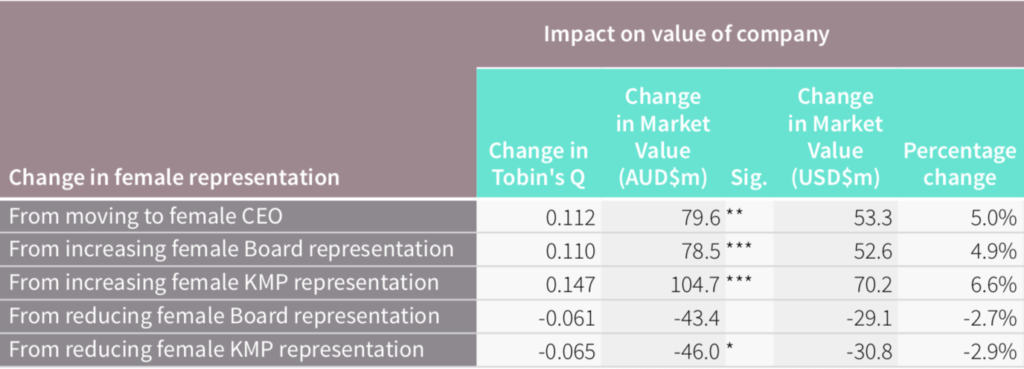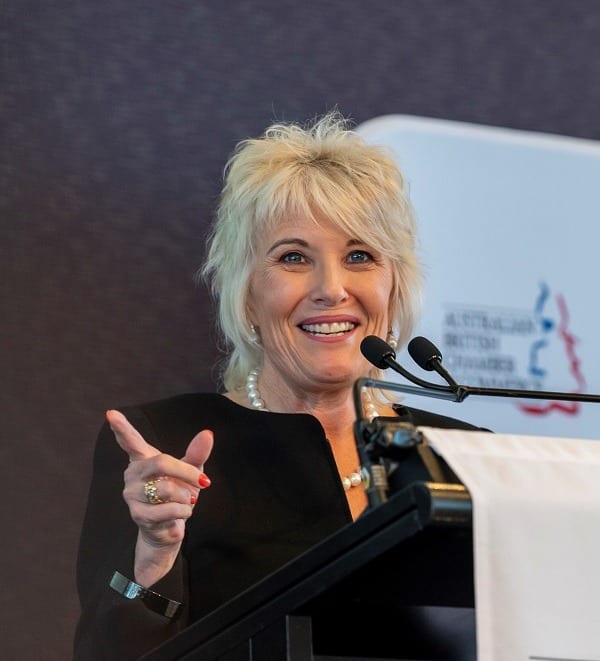As businesses look to a post COVID-19 recovery, they can’t overlook this new analysis that finds a compelling link between female leadership and profitability, performance and productivity.
The new research out today essentially puts a figure on the additional worth a company can generate by getting more women into key decision-making roles, by finding a strong and convincing causal relationship between company performance and women holding an increasing share of leadership positions within ASX listed organisations.
And that figure is worth more than enough millions to make an investment in all the things we know support and elevate women into leadership roles absolutely worthwhile — like inclusive recruiting processes, real flexible working conditions, paid parental leave and leadership development. These findings should highlight the opportunity in female leadership to help businesses recover and thrive post COVID-19.
There’s a massive 4.9 per cent increase in company market value for those ASX listed companies that achieve an increase of 10 percentage points or more in the share of women on their boards, according to the research by Bankwest Curtin Economics Centre (BCEC) and the Workplace Gender Equality Agency (WGEA).
That’s worth an average $78.5 million.
Companies that increase their share of female Key Management Personnel (KMP) positions see a 6.6 per cent increase in their market value.
And appointing a female CEO also appears to be particularly helpful, resulting in a 5 per cent increase in market value for those ASX-listed companies that have done so, worth an average $79.6 million.
It goes the other way for companies too: the researchers found that those companies that reduced the share of women as key managers by ten percentage points or more faced a market value reduction of 2.9 per cent, or an average $46 million.
Despite these findings, getting to even 30 per cent female representation on the boards of ASX 200 entities has taken serious work, and the proportion of women represented is significantly less across the full ASX. Three in ten companies within the available WGEA dataset (the 4,841 entities that reported to the agency during the 2018/19 period analyzed) still have no women represented on them at all. And 27.5 per cent of companies have no women in their key management teams.
As WGEA Director Libby Lyons says in the introduction to this report: “The findings mean that, if you are a business leader, you no longer have an excuse for avoiding action.”
“This ground-breaking study has provided important new evidence of the crucial need for improving gender diversity in company leadership. As we ‘snap forward’ to a post-COVID-19 economy, this report demonstrates that CEOs and senior executives must include gender equality as they develop recovery plans.”
Workplace gender equality has very much moved from the “right thing” to do. It’s now the key thing to do for your employees and your shareholders. During an economic downturn in which women’s workforce participation is at risk of going even further backwards, these findings show that one of the best things companies can do is get more women into leadership, and support those who are rising up the ranks.
Estimated impact on company performance of increasing or decreasing female leadership:

Notes: Projections are presented at the average company market value and average value of common equity for Australian ASX-listed companies. Estimates are flagged as statistically significant (Sig.) at 1% (***), 5% (**) and 10% (*).
Source: Bankwest Curtin Economics Centre | Authors’ estimates from WGEA Gender Equality data 2014 to 2019.
According to the report authors, the key data findings include:
- An increase of 10 percentage points or more in female representation on the Boards of Australian ASX-listed companies leads to a 4.9 per cent increase in company market value or the equivalent of AUD$78.5 million on average
- An increase of 10 percentage points or more in the share of female key management personnel leads to a 6.6 per cent increase in market value of Australian ASX-listed companies, or the equivalent of AUD$104.7 million on average;
- Having a female CEO leads to a 5.0 per cent increase in market value of Australian ASX-listed companies, or the equivalent of AUD$79.6 million on average;
- An increase of 10 percentage points or more in female representation on Boards leads to a 6.0 per cent increase in the likelihood of outperforming their sector on three or more metrics;
- An increase of 10 percentage points or more in the share of female key management personnel leads to a 5.8 per cent increase in the likelihood of outperforming their sector on three or more metrics;
- Having a female CEO leads to a 12.9 per cent increase in the likelihood of outperforming their sector on three or more metrics.
* The six key metrics used are return on equity, earnings before interest and tax (EBIT), sales per worker, return on assets, dividend yield and Tobin’s Q.

